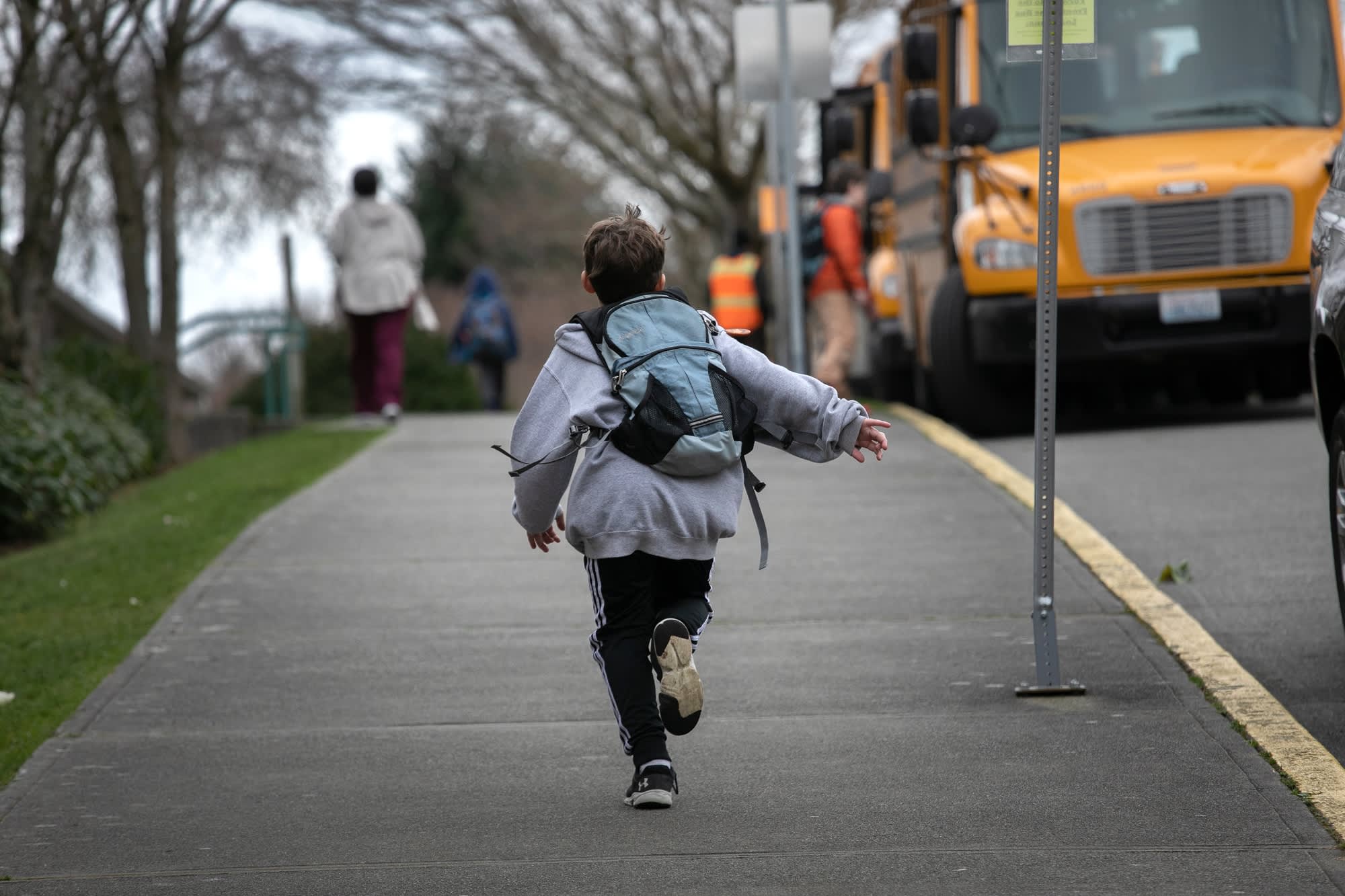A student leaves the Thurgood Marshal Elementary school after all Seattle Public Schools were abruptly closed due to coronavirus fears on March 11, 2020 in Seattle, Washington. Schools will be closed for a minimum of two weeks. The system is the largest public school district in Washington State.
John Moore/Getty Images
Distance learning got off to a rough start in this past spring.
Fall might not be much better and the stakes now are higher.
Across the country, reopening plans vary, with many school districts still scrambling. Even in areas that are planning to return to in-person learning, students may not resume a full-time schedule.
Going forward, students will likely see smaller classes and staggered scheduling, which could include alternating days of the week or times of the day, to help limit the number of people physically present in a building at any time, according to guidelines set by the American Federation of Teachers.
One thing is certain: After it is deemed safe to return to class, it won’t be a return to what was once considered normal.
More from Invest in You:
Taking a gap year will be different amid pandemic
Here’s the short list of colleges offering tuition discounts
How to avoid getting crushed with student loan debt
The coronavirus crisis laid bare how ill-prepared most schools had been when it came to remote learning. From grade school through graduate school, many institutions struggled to get up to speed as classes moved online nearly overnight.
Research by the Collaborative for Student Growth at NWEA, a national nonprofit that assesses learning, found that school closures due to Covid-19 will likely result in substantially lower achievement levels.
Among students, most said the quality of their online classes in the spring was fair or poor, according to a separate survey by the nonprofit Junior Achievement USA.
Yet when it comes to distance learning, the shortcomings are not shared equally.
“It’s not fair to kids because it’s not across the board,” said Mayssoun Bydon, founder and managing partner of The Institute for High Learning, or IHL Prep, an educational consulting firm.
The children without internet or adequate access to computers at home suffer the most, added Ed Grocholski, a senior vice president at Junior Achievement USA.
“The biggest concern is that you have this digital divide and you’ll end up with an educational gap,” he said.
When broken down by race, household income or level of education, the differences are striking.
Nearly all, or 99%, of families in the highest income bracket had home internet access compared to 87% of those in families in the lowest bracket, according to the National Center for Education Statistics.
The discrepancy is nearly the same for parents with a college or graduate degree compared to parents with a high school diploma and for Asian-American or White families compared to Black families.
As schools brace for the fall, the imbalance may become more pronounced when it comes to a public versus private education.
Private schools could have more flexibility when it comes to adhering to the standards for reopening, according to Myra McGovern, a spokesperson for the National Association of Independent Schools.
“When you have 30 kids in a classroom you can’t bring them all back on campus,” Bydon said. “When you have 10 students in a class, it’s much easier.”
That could make independent schools particularly desirable for parents who need their children to be in school so they can go to work — or rely on school for meals or as a safe haven.
But it comes at a cost. On average, tuition at private schools across all grades is $26,866 a year, according to the National Association of Independent Schools.
Whether you are paying for it or not, education is a right in America.
Mayssoun Bydon
founder of IHL Prep
“We are about to see more wealth inequity divide than we ever have,” Bydon said. “We all know about the wealth inequities that exist in our society.
“As parents, it hits you much harder when it comes down to the education of your child,” she added. “Whether you are paying for it or not, education is a right in America.”
Akin to what is happening at elementary, middle and high schools, colleges are also split on reopening plans, with the vast majority adopting a hybrid approach in the fall.
As of a recent tally, 87% of institutions plan to combine in-person and virtual learning, according to a report by the Institute of International Education that was based on data collected in July from more than 500 colleges and universities in the U.S.
Yet, undergraduates have voiced extreme dissatisfaction with remote learning, as well, particularly at the same high cost they were previously paying for an in-person education.
Meanwhile, tuition and fees plus room and board for a four-year private college averaged $49,870 in 2019-20; at four-year, in-state public colleges, it was $21,950, according to the College Board.
Of the colleges that have said they will reopen, the majority are implementing strict safety measures, such as making masks mandatory, restricting social events and postponing all study abroad programs indefinitely.
For Hannah O’Neil, 20, sacrificing a semester abroad and adhering to those guidelines on campus are concessions she is willing to take in order to be at school later this month.
Above all else, the junior at Hope College in Michigan said she and her classmates were hoping to return after months of studying at home in isolation.
“Most everyone wanted to be in person, they’re just excited to see everyone again.”
SIGN UP: Money 101 is an 8-week learning course to financial freedom, delivered weekly to your inbox.
CHECK OUT: The side hustle I spent $250 to start is now my full-time, six-figure job: Here’s my best advice via Grow with Acorns+CNBC.
Disclosure: NBCUniversal and Comcast Ventures are investors in Acorns.
